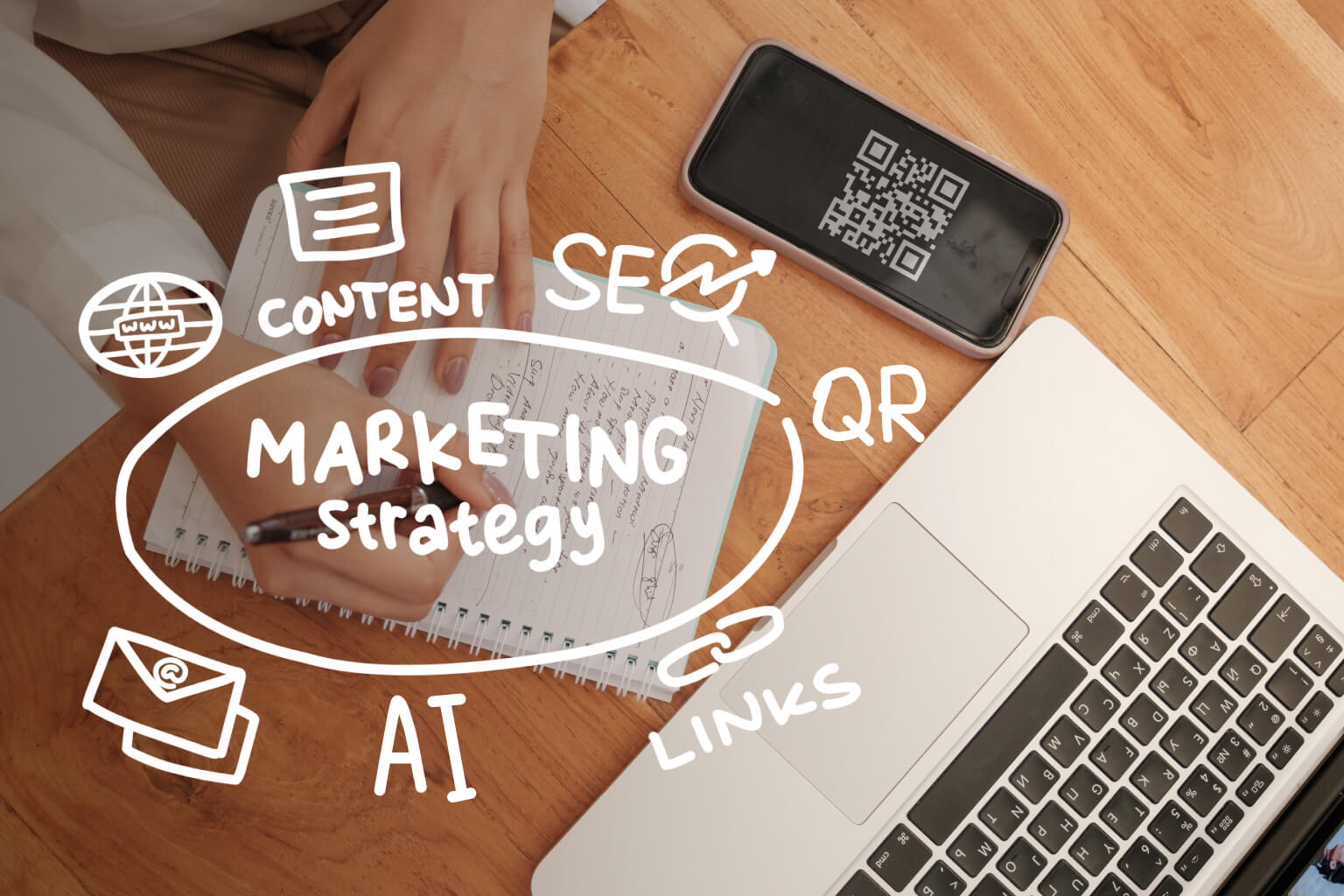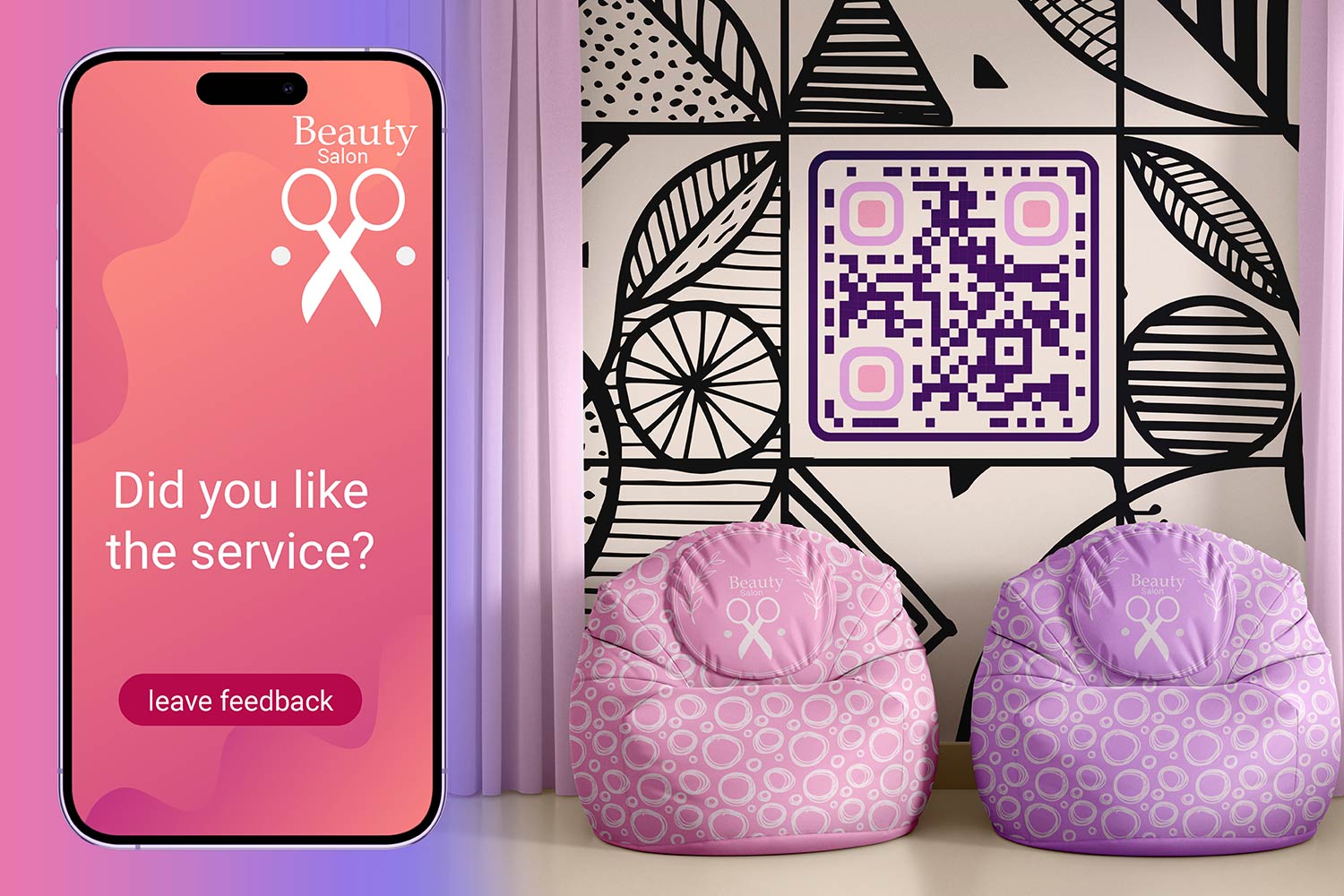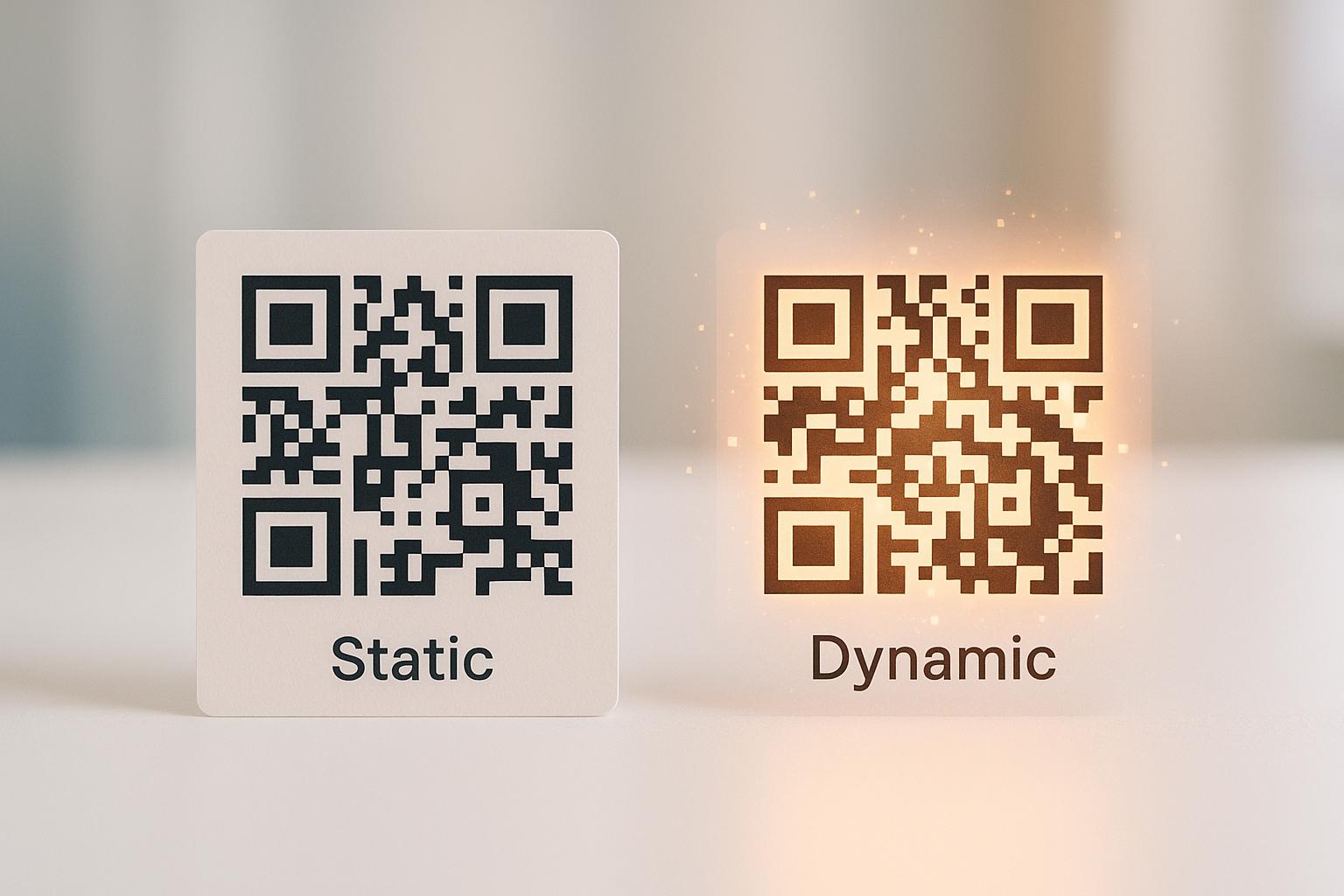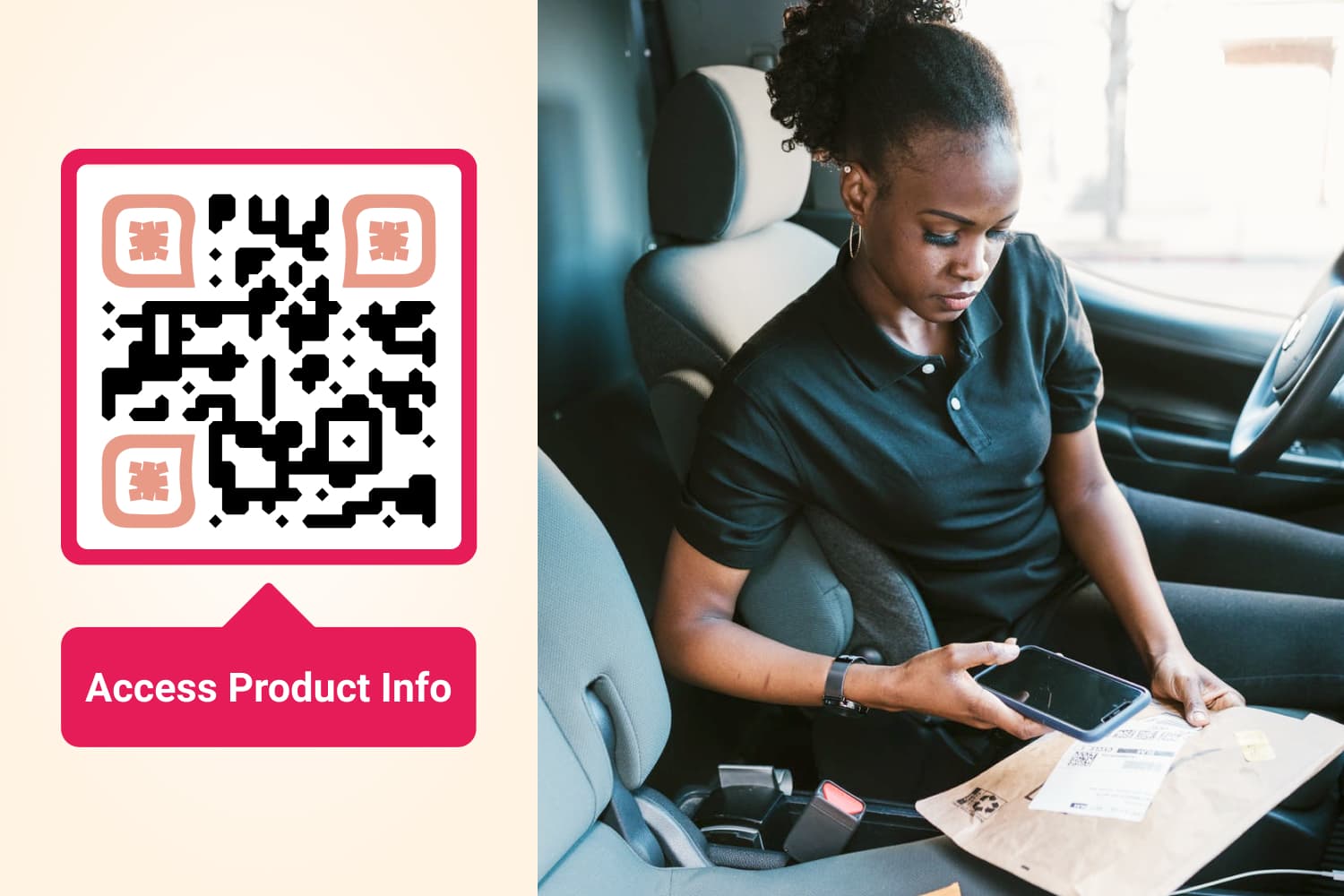AI is transforming QR code marketing by making it smarter, more personalized, and data-driven. Here’s what you need to know:
- Dynamic QR Codes: AI allows QR codes to adapt in real-time based on location, time, or user preferences. Example: A restaurant QR code changes its menu offerings throughout the day.
- Custom Designs: AI integrates brand colors, logos, and visuals into QR codes without losing scannability, boosting brand recognition.
- Improved Analytics: AI-powered QR codes provide detailed insights, like user behavior and scan locations, helping businesses refine campaigns.
- Higher Engagement: Campaigns using AI-enhanced QR codes report up to 60% higher engagement rates and 25–40% better scan rates than traditional codes.
- Industry Use Cases: From retail to healthcare, AI-powered QR codes personalize offers, improve accessibility, and even combat counterfeiting with blockchain integration.
Why It Matters:
AI-powered QR codes are not just links – they are tools for creating personalized, engaging, and measurable customer experiences. Ready to elevate your campaigns? Start leveraging AI-enhanced QR codes today.
GoHighLevel QR Code Marketing Made Easy (Step-by-Step Tutorial)
How AI Transforms QR Code Design and Functionality
Artificial intelligence is reshaping the way QR codes look and operate, turning them from basic, static designs into sophisticated tools for marketing and customer engagement. With AI, QR codes now blend seamlessly with brand visuals while offering features that adapt to user needs in real time.
Dynamic QR Codes for Personalized Experiences
AI has introduced a game-changing feature for QR codes: dynamic functionality. Unlike static QR codes that always lead to the same destination, AI-generated dynamic QR codes adjust their content based on context. Factors like location, time of day, user device, or past interactions can influence what the code displays. This adaptability opens the door to real-time customization.
For instance, imagine a restaurant using a single QR code on their menu. In the morning, it could display breakfast options. By lunchtime, it shifts to the day’s specials, and by evening, it highlights dinner selections. The same code could even switch languages depending on the user’s device settings or location.
This level of personalization is making a big impact. AI-enhanced QR codes see scan rates improve by 25-40% compared to traditional ones. The increase comes from their ability to deliver a tailored and user-friendly experience.
Platforms like Pageloot make it easy for businesses to create QR codes that can be updated without reprinting. Whether it’s for business cards, flyers, or product labels, these dynamic codes ensure your materials stay relevant with minimal effort.
Custom Designs with Brand Integration
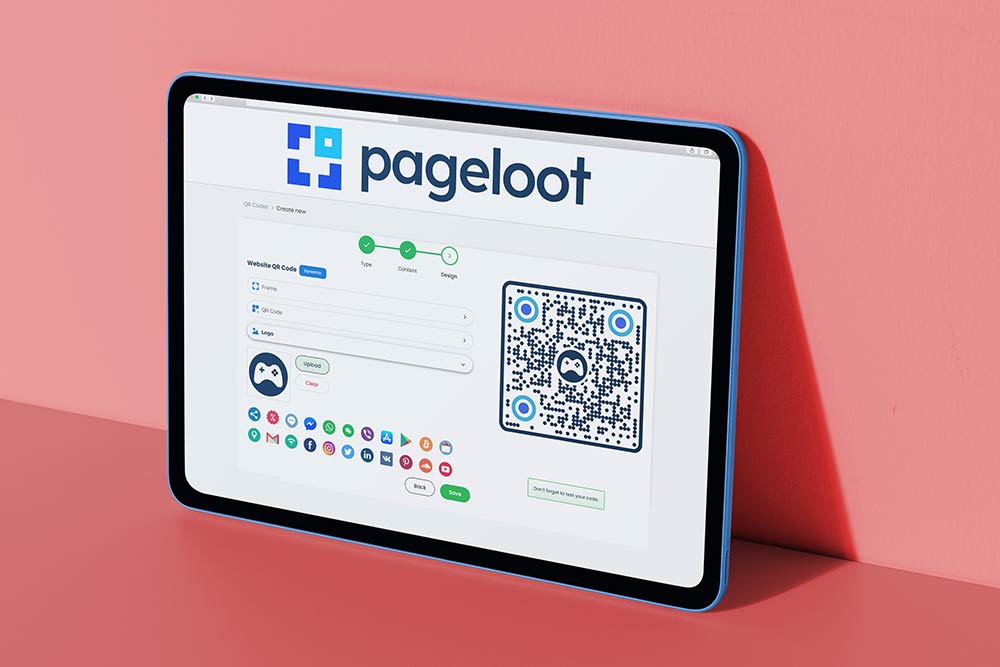
One of the biggest challenges with traditional QR codes has been their lack of visual appeal. Standard black-and-white designs often feel disconnected from a brand’s identity. AI changes this by enabling QR codes to integrate logos, brand colors, and design elements while maintaining scannability.
AI-powered tools automatically adjust the placement, size, and contrast of design elements to ensure the code remains functional across devices. For example, the technology optimizes logo placement to balance usability with brand visibility. This approach not only reinforces brand recognition but also increases engagement rates.
Whether you’re designing QR codes for marketing agencies, e-commerce platforms, or healthcare services, AI ensures your codes don’t just work – they enhance your brand’s professional image.
Improved Scan Reliability and Analytics
AI also takes QR code performance to the next level by improving both reliability and data insights. Scanning accuracy has increased by 25% thanks to AI algorithms, which means fewer failed scans and smoother user experiences.
This reliability comes from AI’s ability to process images intelligently. It compensates for distortions, enhances image quality, and even reconstructs missing data. So, whether someone scans a QR code on a vehicle under bright sunlight or a poster in dim lighting, the code works as intended.
On the analytics side, AI turns raw scan data into actionable insights. Instead of just tracking the number of scans, businesses can now understand user behavior – like who scanned the code, when and where it was scanned, and what actions followed. For example, in 2023, L’Oreal reported that 63% of consumers were more likely to engage with brands that used augmented reality features through QR codes. This highlights how AI-powered QR codes can go beyond simple redirection to create deeper customer interactions.
AI in QR Code Marketing Campaigns: Practical Applications
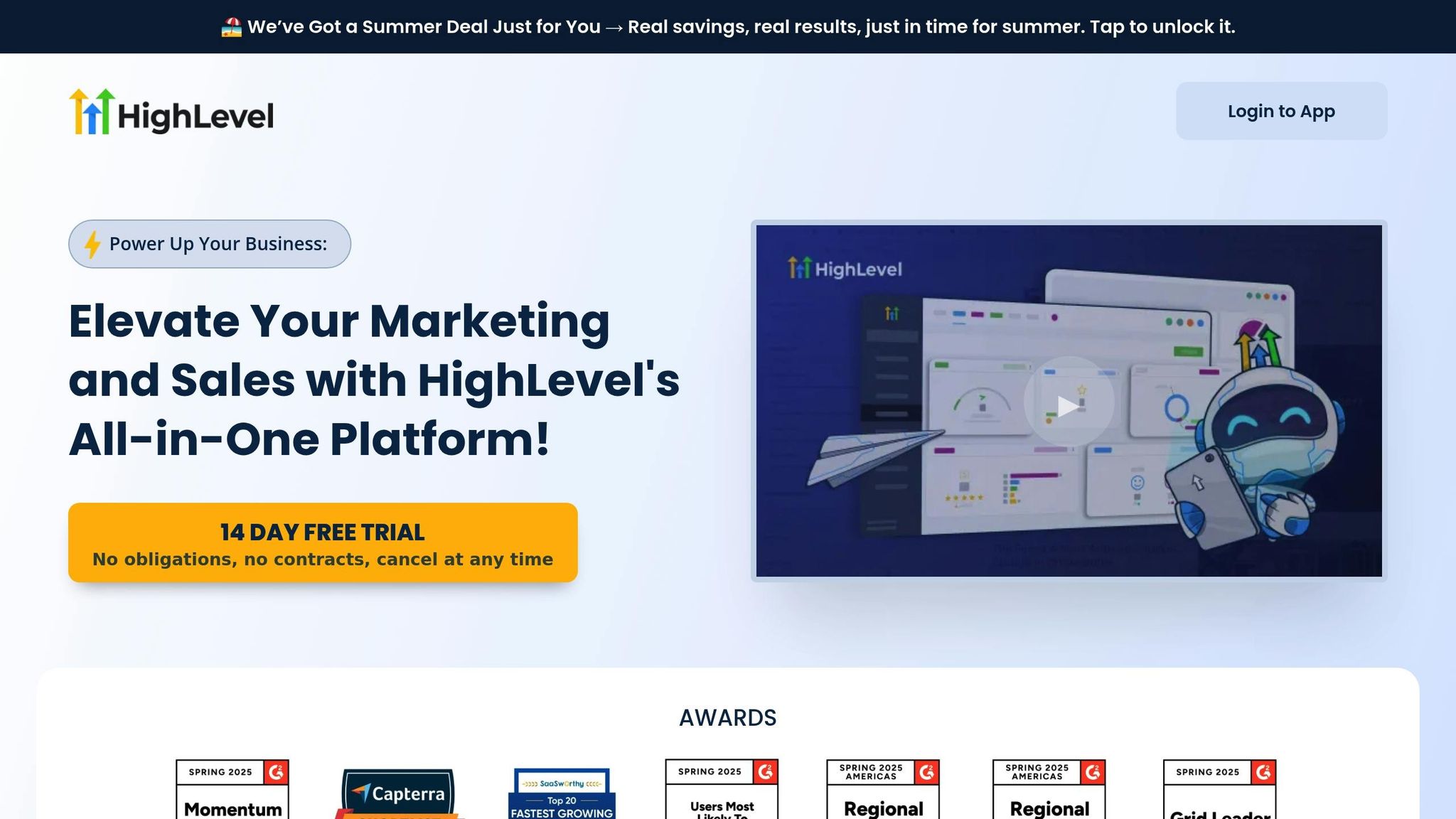 AI has taken QR code marketing to a whole new level, creating seamless connections between offline and online platforms. These AI-powered QR codes are transforming the way businesses engage with customers across industries, offering dynamic and personalized marketing experiences.
AI has taken QR code marketing to a whole new level, creating seamless connections between offline and online platforms. These AI-powered QR codes are transforming the way businesses engage with customers across industries, offering dynamic and personalized marketing experiences.
Cross-Channel Marketing with Personalized QR Codes
AI-powered QR codes are becoming a key tool for bridging the gap between physical and digital marketing. Instead of isolating each channel, businesses are crafting campaigns that move with customers, no matter where they are.
Take Hershey’s, for example. They added two QR codes to their Kisses chocolate packaging: one for the giver to record a video message and another for the recipient to view it. This simple addition turned an everyday product into a heartfelt gift, deepening the emotional bond with the brand.
McDonald’s also got creative with QR codes. In the Philippines, they used massive QR displays at select locations to promote discounts. The result? A surge in foot traffic, as the digital offer was impossible to miss.
Consistency across platforms plays a huge role in boosting revenue – companies that maintain a cohesive visual identity see up to a 23% increase in revenue. By customizing QR codes with brand colors and logos, businesses can reinforce recognition, whether on business cards, flyers, or product packaging.
Personalization is where QR codes truly shine. With 72% of consumers saying they only engage with tailored messaging, AI-powered QR codes deliver exactly that. These codes adapt based on user data like location, device type, or past interactions, ensuring every scan leads to content that feels relevant.
"The ability to segment customers and deliver personalized experiences is a game-changer for marketers." – Marc Benioff, CEO, Salesforce
The numbers back this up: businesses using AI-driven personalization see customer engagement rates double, with sales increasing by about 20%. This success stems from delivering the right message, at the right time, through the right channel.
These cross-channel innovations naturally extend into specific industries, offering tailored solutions for unique challenges.
Industry-Specific Use Cases

AI-enhanced QR codes are finding their way into diverse industries, solving problems and enhancing customer experiences in creative ways.
Healthcare has seen rapid adoption of QR technology. During the pandemic, Boston Children’s Hospital used QR codes outside patient rooms to let families join Zoom calls with care teams, enabling virtual participation when in-person contact wasn’t possible. Philips Healthcare uses QR codes on medical devices to give instant access to user manuals, troubleshooting guides, and maintenance schedules – a practical solution for healthcare professionals.
"With ConnectQR, we’ve reduced admin time and made patient communication seamless." – Sean J, Southern Point Regional Medical Centre
Retail and e-commerce are leveraging AI QR codes to offer dynamic pricing, personalized recommendations, and targeted promotions. Sephora, for instance, uses QR codes to provide instant access to product details, beauty tutorials, and even virtual try-ons. They’ve also integrated QR codes into their loyalty programs, offering exclusive rewards and discounts that keep customers coming back.
Food and beverage brands are creating immersive customer experiences with QR technology. Jameson launched "Jameson Connects", a digital platform accessible via QR codes on bottle necks. Scanning these codes unlocks cocktail recipes, early event access, and exclusive merchandise, turning a single purchase into an ongoing relationship with the brand.
Accessibility and inclusion are also benefiting from AI-enhanced QR codes. In 2021, Kellogg’s introduced NaviLens codes on cereal boxes in 60 Co-op supermarkets in the U.K., later expanding across Europe. These specialized QR codes allow visually impaired consumers to scan products from up to 10 feet away, with the app reading out ingredient lists and allergy warnings.
The flexibility of AI-powered QR codes makes them a fit for virtually any industry. Whether you’re running a marketing agency, managing restaurant operations, or working in real estate, these tools can be customized to meet specific needs while providing valuable analytics to refine strategies.
With nearly 99.5 million U.S. smartphone users expected to scan QR codes by 2025, businesses that embrace AI-enhanced QR code strategies now will be ready to capitalize on this growing trend. These examples prove that AI-driven QR codes are not just adaptable – they’re essential for modern marketing.
sbb-itb-74874c9
Measuring Success with AI-Powered QR Code Analytics
AI-powered QR codes turn every scan into a treasure trove of actionable data. Unlike traditional marketing methods, where gauging success can feel like guesswork, these advanced QR codes provide instant, detailed insights. This real-time feedback allows marketers to fine-tune their campaigns with precision.
Real-Time Performance Tracking
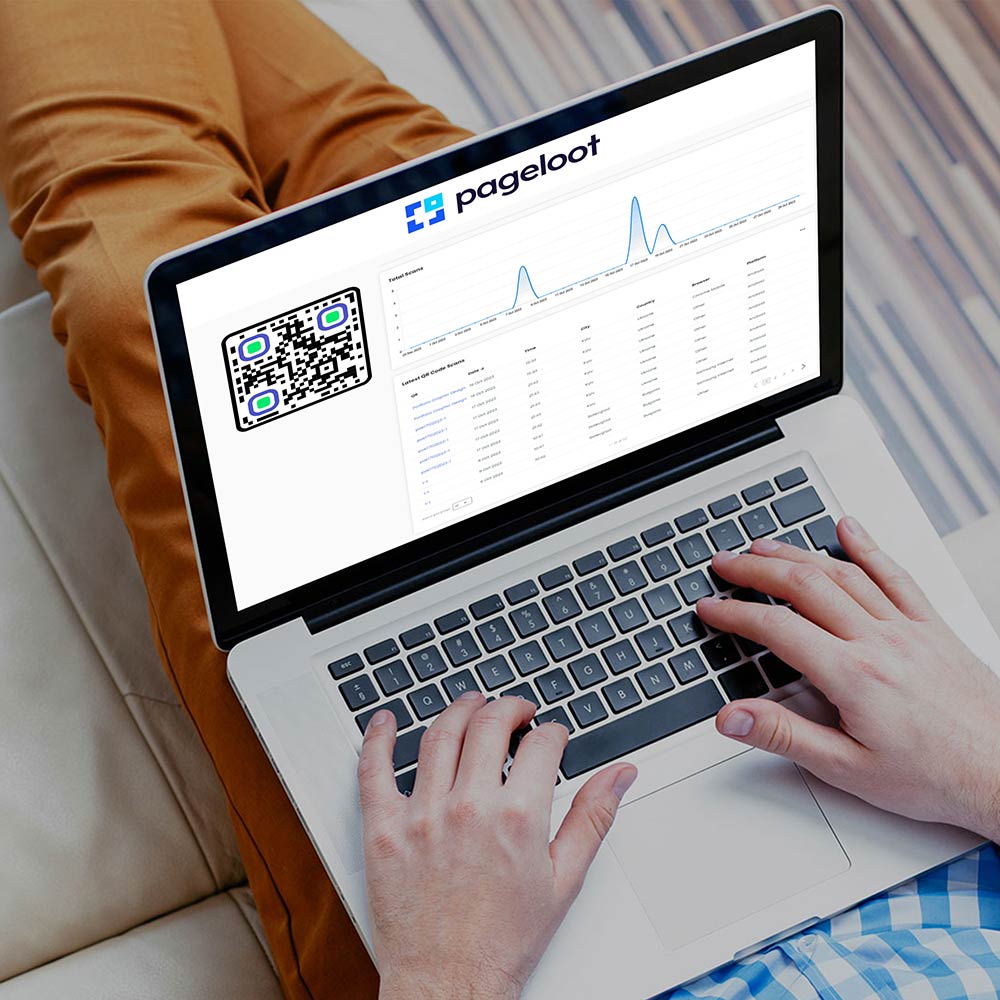
AI-driven analytics platforms take raw QR code scan data and transform it into clear, actionable insights. Through interactive dashboards and smart recommendations, marketers can monitor key metrics like total scans, geographic hotspots, device types, timing, and even conversion rates.
For example, when you create a QR code using platforms like Pageloot, you unlock detailed analytics. These insights reveal not only who scanned your code but also when, where, and what actions they took afterward. This level of data helps marketers zero in on high-intent audiences, fine-tune campaigns based on location, and calculate ROI with accuracy.
"The analytics on Uniqode have been super easy to use and organize. Because of the campaign label function, it became effortless for us to go in and look for specific campaigns. Once the campaigns are sorted, we can begin seeing all the metrics tied into them." – Kinsey Akins, Programmatic Channel Manager, BBQ Guys
Real-world examples highlight the value of these insights. A coffee shop, for instance, discovered that most QR code scans from its mobile truck happened near office parks during weekday lunch hours. Acting on this data, they adjusted their schedule and extended offer windows, doubling redemptions and improving ROI. Similarly, a fitness brand learned that 70% of scans from water bottle QR codes came from Android devices. This insight led to app optimization, boosting their ratings and user retention.
According to Tableau‘s marketing research, AI-driven visualizations can accelerate time-to-insights by 29%. This means marketers can adapt campaigns in real time instead of waiting for post-campaign reviews. These analytics empower teams to create tailored content and make dynamic adjustments on the fly.
AI-Driven Optimization Techniques
AI doesn’t stop at tracking – it actively improves campaign performance through advanced analysis and predictive capabilities. Take the example of a cosmetics brand that tested two QR code designs. The version with a branded look and a personalized call-to-action saw 40% more scans and longer engagement times. This success led to a nationwide rollout, significantly boosting both engagement and conversions.
AI-optimized QR codes often achieve 25–40% higher scan rates compared to standard designs. These gains come from AI’s ability to analyze factors like color schemes, design elements, and scanning patterns to recommend the most effective configurations.
But AI’s impact goes beyond the QR code itself. By analyzing post-scan behavior, it identifies where users convert – or drop off. For instance, a fashion retailer noticed that customers scanning in-store QR codes often abandoned slow-loading mobile pages. By improving page speed and adding a quick "Add to Cart" option, they saw a sharp increase in conversions and a drop in bounce rates.
Predictive analytics takes this a step further. A beauty brand used QR codes on print materials to promote exclusive offers. Scanners were tagged via Meta Pixel and later targeted with social ads featuring the same products. This multi-layered strategy drove a 3.2× lift in conversions – all from a single QR code scan.
Geographic and timing insights also play a key role in targeting. A gym wear brand placed QR codes on billboards with a "Scan for 20% off" offer. They noticed scan spikes after fitness classes near colleges. Using this data, they launched highly targeted campaigns at peak times, successfully increasing engagement and conversions.
Future Trends in AI-Powered QR Code Marketing
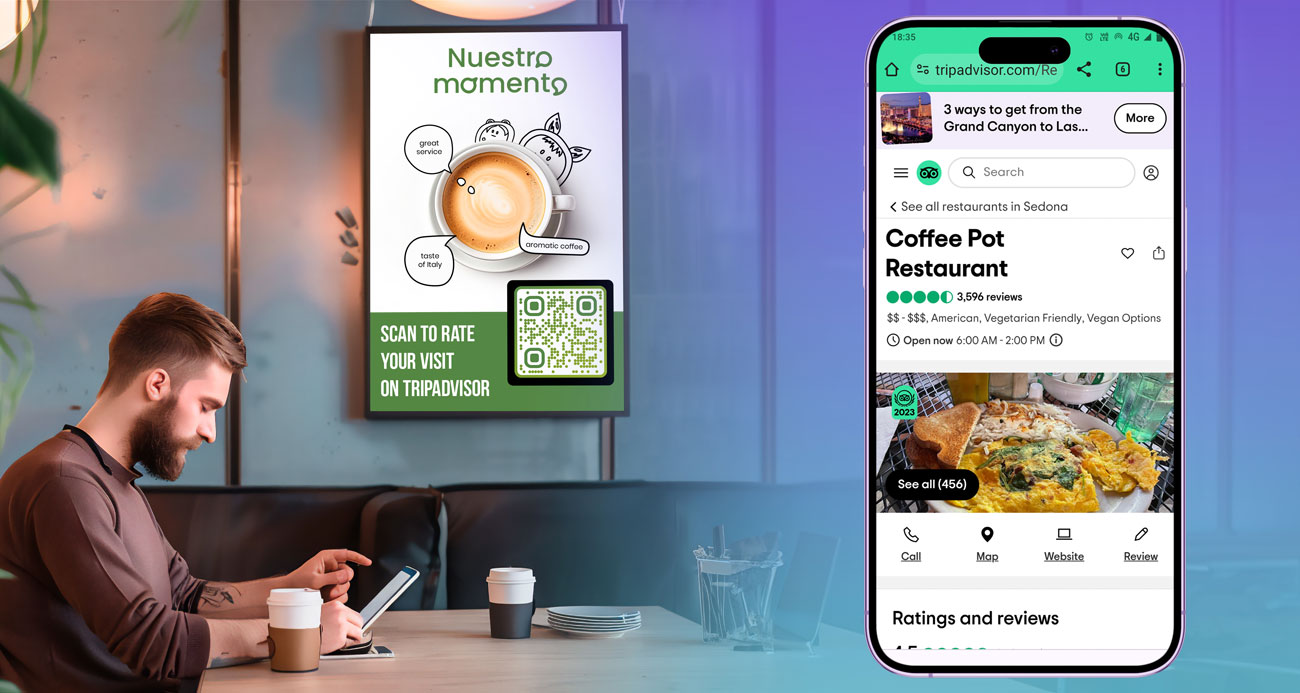
The fusion of AI and QR code technology is evolving at an incredible pace. With 77% of devices now incorporating AI and the market for AI projected to grow by over 120% year-over-year, the potential for transformation is immense. By 2030, AI is expected to contribute a staggering $15.7 trillion to the global economy. Naturally, QR code marketing is poised to ride this wave of innovation.
AI is reshaping the way businesses understand customers and market dynamics. This shift is opening doors for QR codes to become smarter, more secure, and deeply integrated with cutting-edge technologies. The result? A future where personalization and predictive analytics take center stage.
Advanced Personalization and Predictive Analytics
AI-powered QR codes are moving toward creating deeply personalized experiences that adapt instantly based on user data, location, and behavior. Instead of leading every user to the same destination, future QR codes will analyze the scanning context and deliver tailored content on the spot.
Predictive analytics is set to revolutionize how businesses anticipate customer needs. By analyzing past scan data, AI can uncover trends before they fully emerge, enabling marketers to design campaigns that offer personalized product recommendations based on prior interactions.
Retailers are already leveraging this technology. For instance, in-store QR codes are being used to provide customized recommendations based on purchase history or even skin type. AI also offers businesses a clearer understanding of customer behavior, market trends, and competitor tactics. This means QR code campaigns can go beyond simply tracking who scanned a code – they can delve into motivations and predict future needs.
"AI is changing everything – data analytics, building models, and even writing better code. But it only works when the right people are empowered to use it." – Jeff Tarran, CEO of Gundir
Future QR code generators will rely on machine learning to adjust content dynamically, taking into account scanning patterns, seasonal trends, and user profiles. This evolution will make QR codes on business cards, flyers, and posters far more effective at driving engagement and conversions.
But the story doesn’t end with personalization. The integration of emerging technologies promises to take QR codes to the next level.
Integration with Emerging Technologies
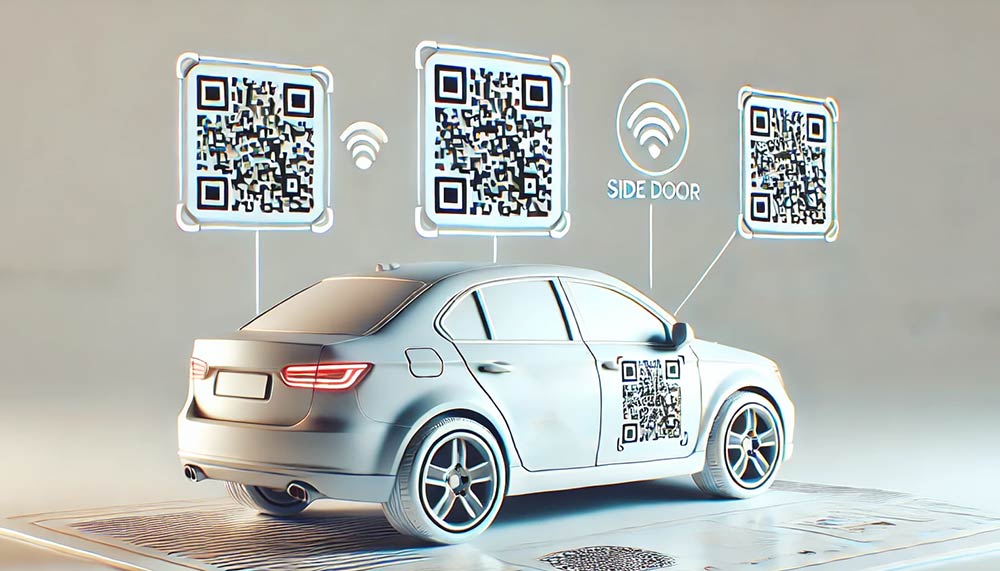
The next chapter in QR code innovation lies in its integration with augmented reality (AR), Internet of Things (IoT), and blockchain technologies. These combinations are creating immersive and secure experiences that go far beyond simple link redirection.
AR Integration: Companies like Nike are already using QR codes on sneaker boxes to trigger AR experiences, allowing customers to view holograms of shoes before purchasing. As AR becomes more accessible and QR code design capabilities improve, this kind of interaction will expand across industries.
Blockchain for Security: Luxury brands such as Gucci and Louis Vuitton are embedding blockchain-enabled QR codes on products to combat counterfeiting. These codes let buyers verify authenticity instantly. Given that QR code scams now account for over 20% of online scams, blockchain integration is becoming increasingly critical.
IoT Applications: QR codes are also playing a role in IoT-enabled packaging. For example, Napolina’s tomato tins feature QR codes that allow consumers to trace the product’s journey from farm to table. As IoT technology advances, this kind of transparency will become more widespread, offering real-time data and building consumer trust.
AI is also pivotal in improving QR code security. Enhanced systems can now detect phishing attempts and alert users to dangerous links. In fact, one Chinese payment provider reduced fraud rates by 60% in just one year using AI-driven fraud detection, while Safaricom’s M-PESA reported a 75% drop in fraudulent transactions after adopting similar measures. The combination of AI and blockchain in QR payment systems is likely to become a standard feature, ensuring real-time fraud detection and secure transactions.
Emerging innovations like 3D-printed QR codes offer greater durability for industrial applications, while invisible QR codes using UV or infrared ink are paving the way for enhanced product authentication. These advancements are set to expand QR code use in industries like construction, healthcare, and manufacturing, further broadening their potential.
With over 2.2 billion people expected to use QR codes by 2025 and more than 2.3 billion QR code coupons projected to be redeemed, the convergence of AI and QR technology is reshaping digital marketing. Businesses that embrace these advancements early will position themselves as leaders in customer engagement and conversion.
Ready to take the leap? Use our free QR generator to create AI-powered QR codes tailored to your next campaign.
Conclusion
AI-powered QR codes are reshaping marketing campaigns by delivering highly personalized experiences. Businesses adopting smart QR code solutions have reported engagement rates that are 60% higher, while AI-optimized codes achieve 25-40% more scans compared to standard ones, highlighting their effectiveness.
By analyzing customer data, AI tailors content, product recommendations, and promotions to match individual preferences and behaviors. This level of customization not only enhances engagement but also strengthens customer relationships.
In 2023, Avocados from Mexico showcased this potential by using AI-driven QR codes that linked users to personalized pages powered by AI tools. This campaign provided valuable insights into user interaction and demonstrated how AI-enhanced QR codes can deliver measurable results.
AI also enables real-time analytics, offering insights into user behavior, optimal scanning times, and content preferences. This data allows marketers to adjust campaigns dynamically, making decisions based on real performance metrics. These actionable insights refine marketing strategies and help businesses maintain a competitive edge.
The global QR code market is projected to reach $3.78 billion by 2025, with usage having surged by 750% between 2018 and 2020. Businesses that integrate AI-powered QR solutions today are positioning themselves for long-term success. Emerging technologies like augmented reality and blockchain will only expand the possibilities for QR code applications.
With these trends in mind, Pageloot’s AI-powered platform simplifies the process to create a QR code that incorporates advanced features like dynamic content management, real-time analytics, and intelligent design optimization. These tools turn static QR interactions into personalized customer journeys.
Whether you’re creating QR codes for menus, business cards, or large-scale marketing campaigns, AI-enhanced QR codes provide the personalization and insights needed to boost engagement and conversions in 2025 and beyond.
The future of QR code marketing is smarter and more tailored. Start building intelligent campaigns today with our QR code solutions and stay ahead in this evolving landscape.
FAQs
How does AI make QR codes more effective for customer engagement?
AI-powered QR codes take customer engagement to a whole new level by delivering customized experiences and adapting in real time. Unlike the static links of traditional QR codes, these advanced versions can change dynamically based on factors like user behavior, location, or preferences. This allows businesses to share tailored promotions, relevant details, or interactive content that feels genuinely personal and engaging.
On top of that, AI adds a layer of detailed analytics, tracking data like how often the code is scanned, where it’s scanned, and even the type of device used. These insights give businesses the tools to fine-tune their marketing efforts, target the right audience more effectively, and ultimately drive higher conversion rates. By blending AI with QR technology, companies can design smarter, more captivating campaigns that truly connect with their customers.
How can businesses use AI-powered QR codes to enhance their marketing and operations?
AI-powered QR codes are changing the way businesses interact with their customers and manage their operations. With the help of AI, companies can now design personalized QR codes that align with individual customer preferences, delivering targeted promotions or specific content. For instance, retailers can increase sales by offering dynamic discounts based on a shopper’s habits, while restaurants can enhance the dining experience with customized menu suggestions.
In sectors like events and banking, these AI-enhanced QR codes make tasks like contactless check-ins, real-time updates, and secure transactions more efficient. This not only helps businesses run smoother but also provides customers with a more seamless and engaging experience. From marketing to customer service to automation, the potential applications of AI-powered QR codes are virtually limitless.
How can businesses track the success of their AI-driven QR code marketing campaigns?
Businesses can measure the success of their AI-powered QR code marketing campaigns by keeping an eye on metrics like scan counts, engagement rates, and conversion actions – such as purchases or sign-ups that happen after a scan. These numbers shed light on how users are interacting with your QR codes.
For more detailed tracking, you can use tools like UTM parameters, which integrate seamlessly with platforms like Google Analytics. On top of that, advanced QR code services, such as Pageloot, provide real-time analytics to help you monitor performance. These tools reveal user behavior and engagement patterns, giving you the data you need to tweak your campaigns and boost their impact.

